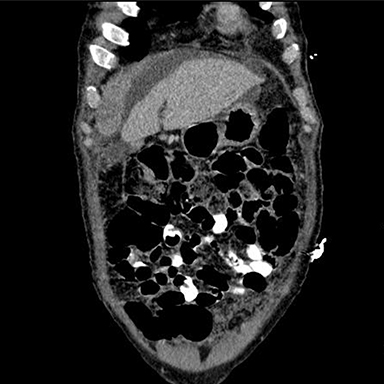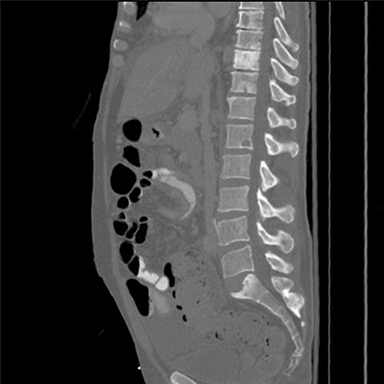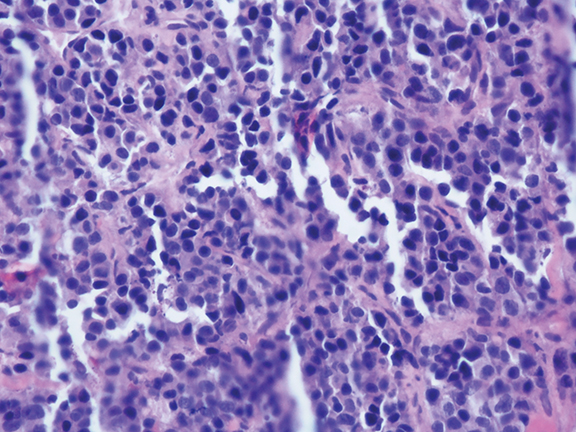Multiple myeloma with peritoneal metastases
Images



CASE SUMMARY
A 50-year-old male with history of cirrhosis secondary to Hepatitis B and C and treated multiple myeloma presented to the emergency department with abdominal distension, confusion, and lethargy. Biochemical investigations were significant for azotemia, hyponatremia, thrombocytopenia, and anemia.
IMAGING FINDINGS
A contrast-enhanced computed tomography (CT) examination of the abdomen and pelvis was compared with a CT angiogram of the chest performed two weeks earlier and showed interval development of a 4.5 cm enhancing soft tissue mass in the right upper quadrant, anterior to the liver (Figure 1). Additional areas of involvement included Gerota’s fascia on the left and the paracolic gutters bilaterally. The skeleton showed both lytic and blastic lesions (Figure 2). CT-guided biopsy was obtained. Ascitic fluid and core biopsies of the suspicious soft tissue mass were submitted to pathology for analysis (Figure 3).
DIAGNOSIS
Multiple myeloma with peritoneal metastases
Multiple myeloma is a hematologic malignancy occurring in 7.4 per 100,000 individuals. Most patients are over 60, but there are reported cases of as young as 40.1 The most common presentation is pain involving the axial skeleton. Multiple myeloma should be considered in a patient with hypercalcemia and renal failure. As with most patients with hematologic malignancy, fatigue is a nonspecific feature of disease.2
Atypical manifestations of disease have been reported. A retrospective chart review of 850 patients with multiple myeloma had classic bone lesions; however, others had atypical imaging findings. Atypical findings included peritoneal carcinomatosis, mediastinal adenopathy, pulmonary mass, hepatic mass and diffuse pelvic sclerosis by radiography.3 Other reports of extramedullary disease include bowel, nodal disease, solid organ disease, and isolated ascites.4-6
Metastatic bone survey is the initial test of choice, classically revealing well defined, punched out, lytic lesions. When closely abutting the cortex, there is endosteal scalloping. Rarely, sclerotic lesions are detected. CT and radiographic findings mirror one another. CT can play a role in detecting extramedullary disease, typically presenting as soft tissue masses or organ infiltration.6 Imaging should be used to detect disease complications, such as fracture.7
PET-CT has the ability to show myeloma deposits in most tissues and can be used to establish a baseline distribution of disease, as well as monitor response to therapy. Findings on subsequent PET-CT studies can guide therapy, depending on the results of follow-up imaging.8
MRI has been shown to be superior to radiography in detecting lesions in the axial skeleton, but inferior in screening for long-bone lesions.9 Therefore, MRI is not an optimal screening tool, but still has clinical value in the management of patients where disease is clinically suspected, but radiographs are negative. The value of MRI is to detect marrow conversion and invasion.10
CONCLUSION
Multiple myeloma typically presents with lytic lesions in the axial skeleton, but may also present in the long bones. Extramedullary disease occurs less frequently, but may occur in the peritoneum, lungs, liver, or lymph nodes, to name a few locations. Radiographic bone survey is used to screen for lytic lesions, but is less sensitive than MRI in the spine. PET-CT can be used to establish a baseline distribution of disease, as well as to monitor response to treatment.
REFERENCES
- Howlander N, et al. SEER Cancer Statistics Review, 1975-2011. 2014 [cited 2015 3/23/2015].
- Palumbo A, Anderson K. Multiple myeloma. N Engl J Med. 2011;364(11):1046-1060.
- Hess T, et al. Atypical manifestations of multiple myeloma: radiological appearance. Eur J Radiol. 2006;58(2):280-285.
- Birjawi GA, et al. Abdominal manifestations of multiple myeloma: a retrospective radiologic overview. Clin Lymphoma Myeloma. 2008;8(6): 348-351.
- Karp SJ and Shareef D. Ascites as a presenting feature multiple myeloma. J R Soc Med. 1987;80(3):182-184.
- Monill J, et al. CT features of abdominal plasma cell neoplasms. Eur Radiol. 2005;15(8):1705-1712.
- Angtuaco EJ, et al. Multiple myeloma: clinical review and diagnostic imaging. Radiology. 2004;231(1):11-23.
- Ferraro R, et al. MR imaging and PET/CT in diagnosis and management of multiple myeloma. Radiographics. 2015;35(2):438-454.
- Lecouvet FE, et al. Skeletal survey in advanced multiple myeloma: radiographic versus MR imaging survey. Br J Haematol. 1999;106(1):35-39.
- Dimopoulos M, et al. Consensus recommendations for standard investigative workup: report of the International Myeloma Workshop Consensus Panel 3. Blood. 2011;117(18):4701-4705.
Citation
JD L, MF C, N V, RJ C.Multiple myeloma with peritoneal metastases. Appl Radiol. 2016; (11):42-43.
November 2, 2016